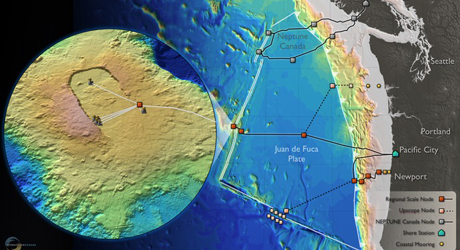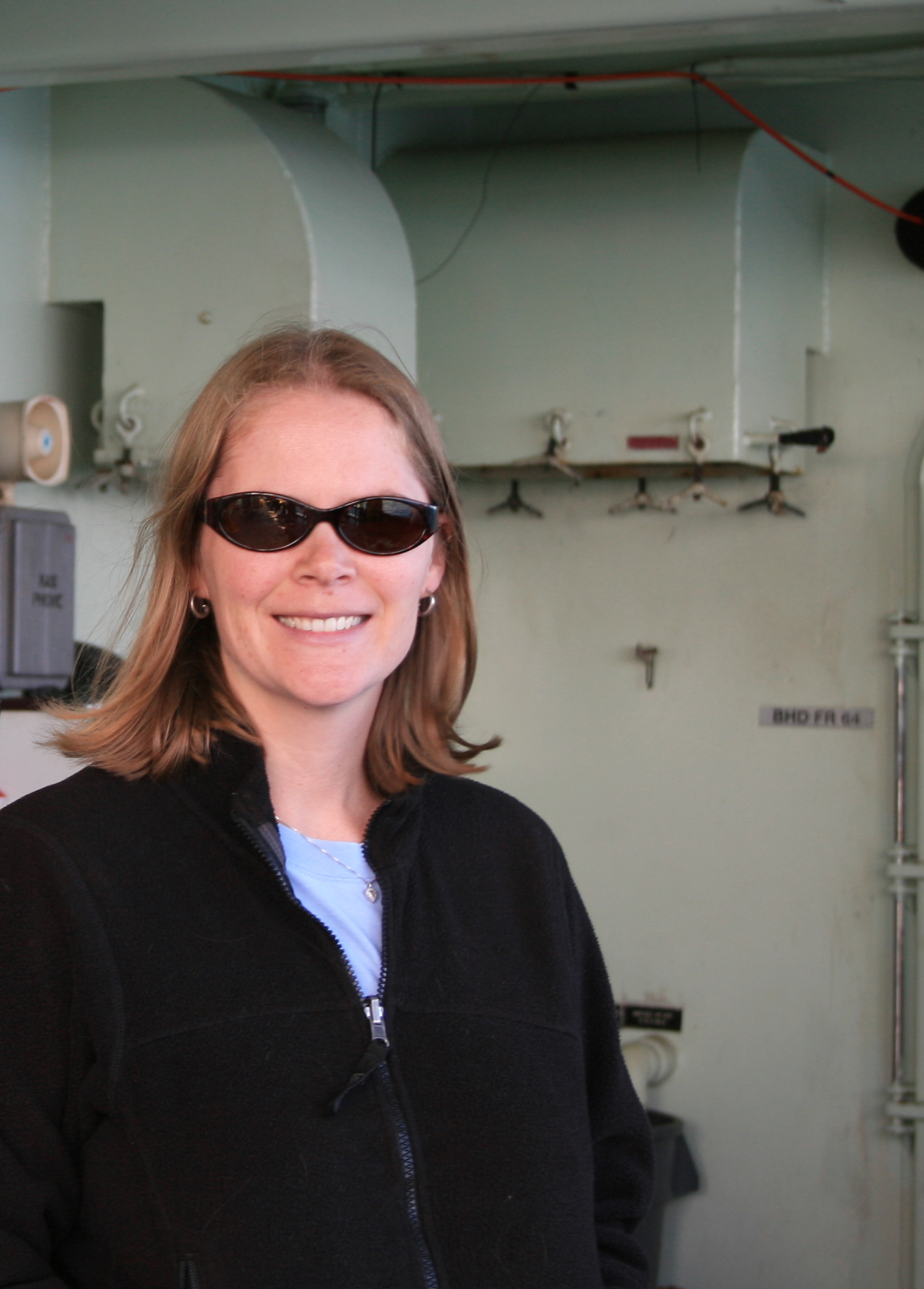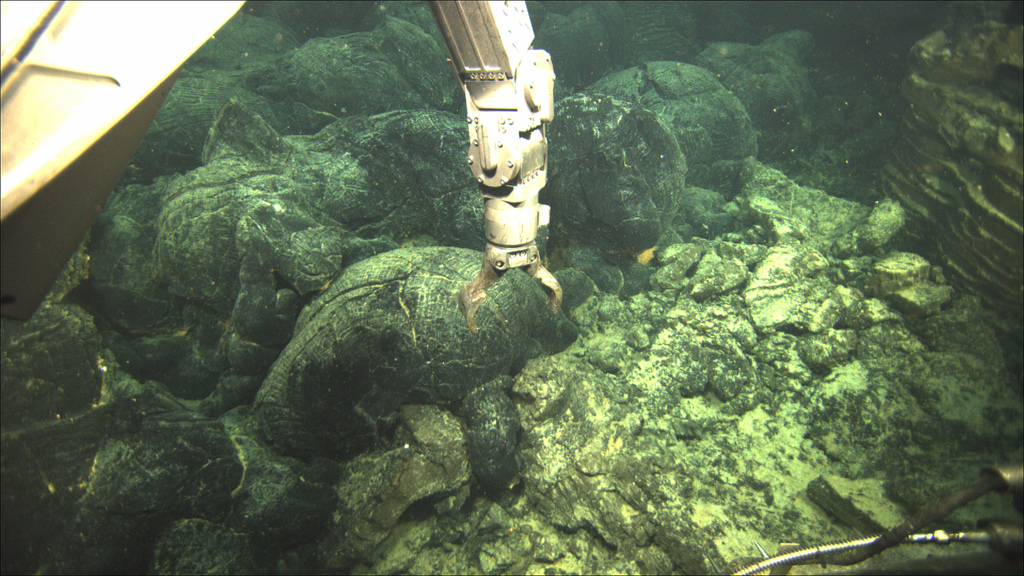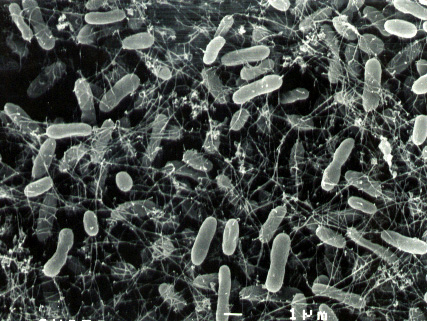MBL Scientists to Explore Hidden Realm of Microbes, Viruses Beneath the Ocean Floor

FOR IMMEDIATE RELEASE: July 20, 2012 CONTACT: Diana Kenney, Marine Biological Laboratory, 508-289-7139; dkenney@mbl.edu
WOODS HOLE, MASS.—The microbes and viruses shrouded in darkness below the ocean floor are bound to become much less mysterious, due to a bold research program led by MBL Bay Paul Center Scientist Julie Huber and her colleagues from several institutions. The program has received a $2.25 million award from the Gordon and Betty Moore Foundation.
“Microbial communities dominate nearly every corner of our oceans, yet they remain vastly under-sampled and our understanding of them is severely limited,” Huber says. This is especially true for microbes that live below the earth’s crust, in the subseafloor, one of largest marine realms but also the hardest to access and explore.
 Plans for the National Science Foundation’s cabled seafloor observatory at Axial Seamount (inset), west of the Oregon coast. Credit: University of Washington.
Plans for the National Science Foundation’s cabled seafloor observatory at Axial Seamount (inset), west of the Oregon coast. Credit: University of Washington.Over the next three years, Huber and her colleagues will undertake novel and at times risky experiments – some at the bottom of the ocean – to understand the microbes and viruses in the subseafloor rocks of Axial Seamount, a deep-sea volcano in the Pacific Ocean about 300 miles west of Oregon.
The scientists aim to “break open the black box of deep-sea microbiology, and take our understanding of subseafloor microbial processes and the carbon cycle to a new level.”
 Julie Huber aboard the research vessel Atlantis (Woods Hole Oceanographic Institution). Credit: Julie Huber
Julie Huber aboard the research vessel Atlantis (Woods Hole Oceanographic Institution). Credit: Julie HuberBecause Axial is a highly active volcano that spews hot fluid from its depths, millions of microbes that are normally buried are pushed up in the vent fluids, where scientists can capture them for study. In 2007, Huber and other MBL scientists discovered an amazing diversity of microbial life in the Axial vent fluids, which were analyzed at the MBL’s Josephine Bay Paul Center.
And yet, they have just scratched the surface of this dynamic ecosystem.
Very little is known about how viruses and microbes interact in the subseafloor, Huber says, which is one focus of their research. “Are the viruses infecting the microbes? Are they killing them? Are they transferring genes? We don’t know. The field of environmental viral ecology has come a long way in the past decade, and we have a picture of how viruses work in the surface ocean. But there have been very few studies in the deep sea.”
The scientists also seek a more detailed portrait of the microbial members of the subseafloor community. They want to know who the “producers” are in this unique food chain—the microbes that, like plants on land, can capture energy, synthesize their own food, and in turn serve as food for other organisms. (On land, the producers capture energy through photosynthesis; in the deep ocean, where there is no light, they rely on chemical energy.)
And finally, a major question is how subseafloor microbes alter the flow of carbon and nutrients in the deep ocean.
“The ocean is a huge sink of carbon, and we know very little about how carbon is moving in the deep ocean,” Huber says. “We are interested in knowing how much carbon is being controlled by microbes in the deep sea; how much carbon is being fixed, and how much is coming out of the vent ecosystem.” This could have important implications, as some nations are considering injecting carbon dioxide from fossil fuel use into the ocean floor, which would have completely unknown consequences.
One of the most exciting prospects is how Huber’s team will sample and analyze the vent fluids. Typically, on research expeditions to deep-sea vents, the ship lowers a remotely operated vehicle (ROV) down to the vent, nearly a mile below the ocean surface. There, the ROV’s robotic arm captures the hot fluid samples and brings them back up through the water column to the ship. After a significant time lag, the samples are analyzed onshore. For the first few years, Huber’s team will follow this traditional method.
 The manipulator arm of the ROV Jason prepares to sample the new lava flow that erupted at Axial Seamount in April 2011. Credit: Bill Chadwick, Oregon State University; copyright Woods Hole Oceanographic Institution.
The manipulator arm of the ROV Jason prepares to sample the new lava flow that erupted at Axial Seamount in April 2011. Credit: Bill Chadwick, Oregon State University; copyright Woods Hole Oceanographic Institution.However, they also plan to develop novel instruments so they can carry out experiments on the seafloor, under conditions more similar to the microbes' habitat.
“The idea is to collect the samples, keep them at in situ pressure and temperature, run an experiment, and then stop it on the seafloor," she says. "We can then analyze the results back in the lab.” This will allow them to compare seafloor and lab experiments and see if they yield the same results.
The project is taking place at an exciting time at Axial Seamount, which is one of the best-studied deep-sea volcanoes in the world. By 2013, Axial will be connected to land by live cable for power and communications, through the National Science Foundation’s Ocean Observatories Initiative (OOI). The protocols that Huber and her team are developing for seafloor sampling and analysis could be integrated into the Axial Seamount node of the OOI.
Joining Huber, who is the lead scientist on the project, are principal investigators Joseph Vallino of the MBL’s Ecosystems Center, who will develop an integrated ecosystem model of subseafloor viral and microbial communities; David A. Butterfield and Giora Proskurowski of University of Washington; James F. Holden of University of Massachusetts, Amherst; and Lisa Zeigler Allen of J. Craig Venter Institute.
Background papers:
Huber JA, et al. (2007) Microbial Population Structures in the Deep Marine Biosphere. Science 318: 97-100.
Chadwick WW, Nooner SL, Butterfield DA, and Lilley, MD (2012) Seafloor deformation and forecasts of the April 2011 eruption at Axial Seamount. Nature Geoscience 5, 1-4.
— ### —
The Marine Biological Laboratory (MBL) is dedicated to scientific discovery and improving the human condition through research and education in biology, biomedicine, and environmental science. Founded in 1888 in Woods Hole, Massachusetts, the MBL is an independent, nonprofit corporation.
The Gordon and Betty Moore Foundation, established in 2000, seeks to advance environmental conservation, scientific research, and patient care. The Foundation’s Marine Microbiology Initiative supports discovery and dissemination of scientific findings and technological developments in the fields of marine microbiology and microbial ecology, which contribute to ocean health and productivity. For more information, please visit www.moore.org.
